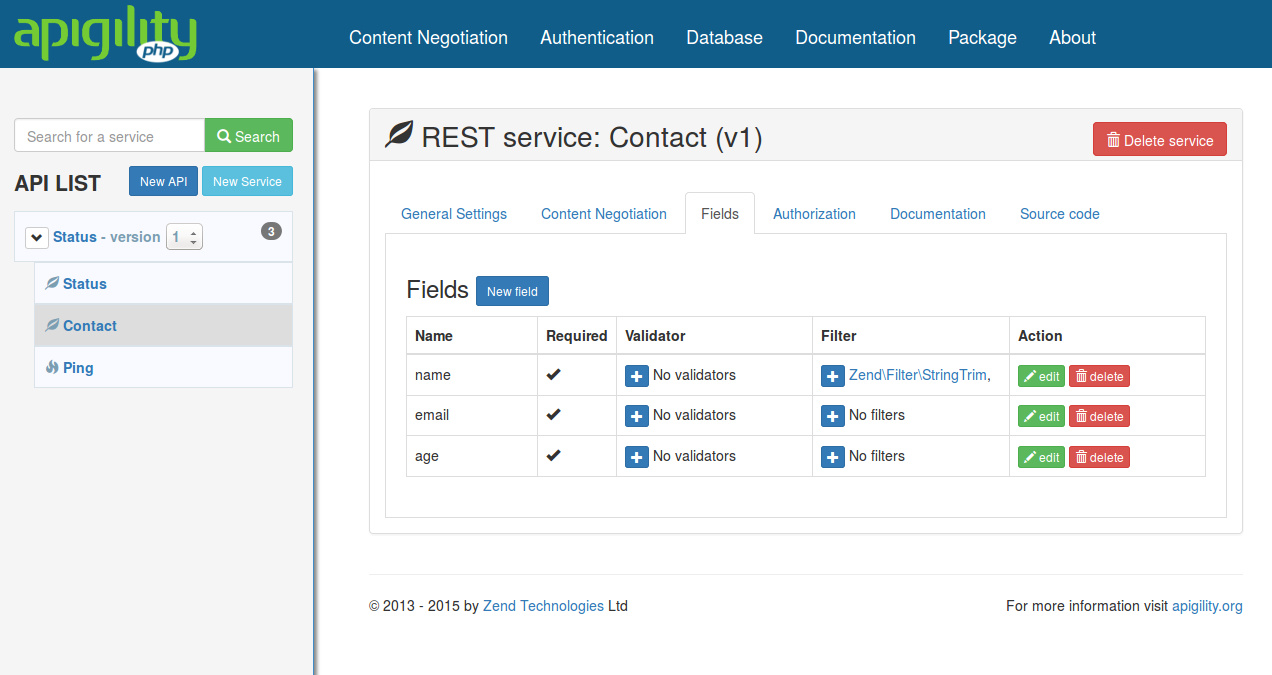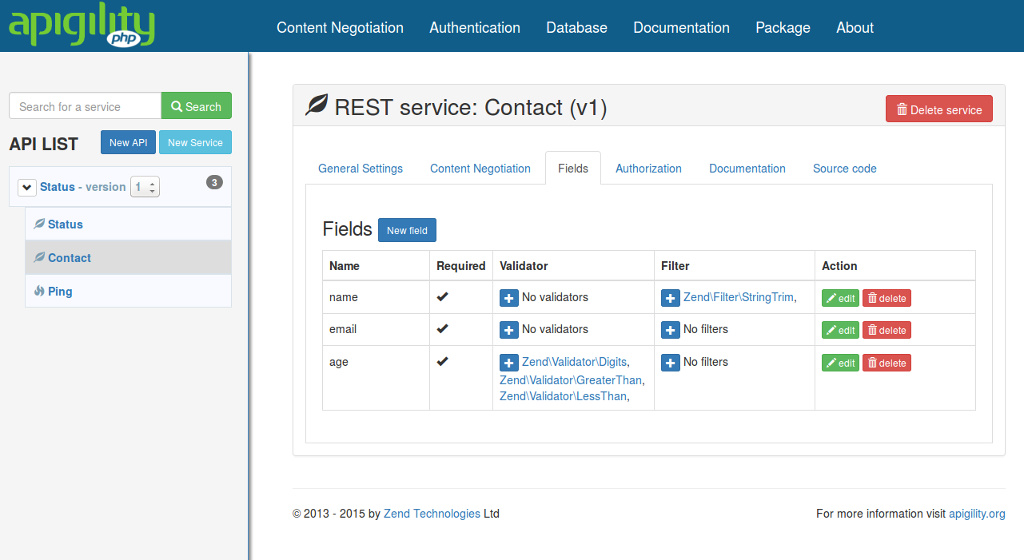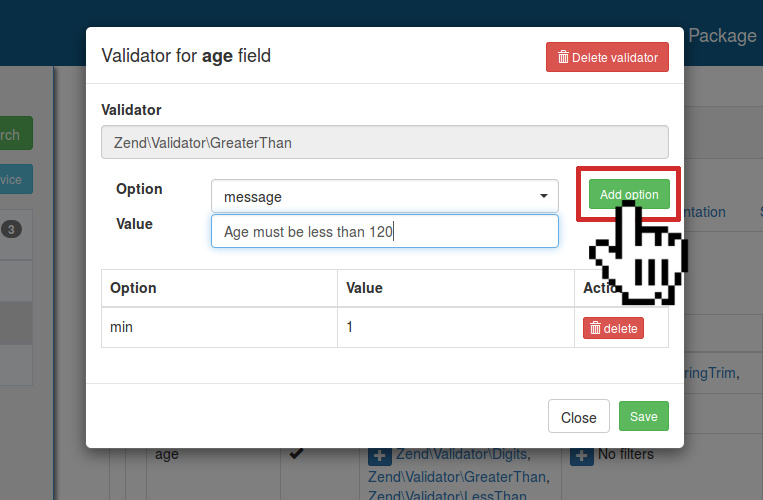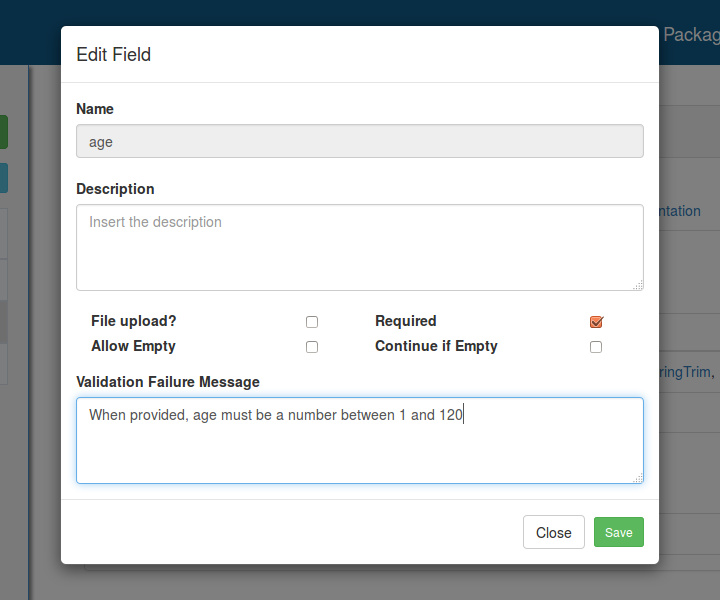Validating
Each field of a service can be assigned a set of validators. When an input filter is present, all
validation must pass in order for the service to be executed. If an input filter does not validate,
a 422 Unprocessable Entity status is returned with a message that the resource failed validation.
In this situation the service will not be executed.
For example, in the following REST Contact service, a contact must provide a valid age. The setup looks like:

Now send a request without an age:
POST /contact HTTP/1.1
Accept: application/json
Content-Type: application/json; charset=utf-8
{
"name": "Ralph",
"email": "foo@bar.com"
}
And the response:
HTTP/1.1 422 Unprocessable Entity
Content-Type: application/problem+json
{
"detail": "Failed Validation",
"status": 422,
"title": "Unprocessable Entity",
"type": "http://www.w3.org/Protocols/rfc2616/rfc2616-sec10.html",
"validation_messages": {
"age": {
"isEmpty": "Value is required and can't be empty"
}
}
}
Note: Allow Empty vs Continue on Empty
When a field is defined as being required and not empty, if those conditions are not immediately met, no other validators will be executed and subsequently their messages will not be returned in the response.
If you want validators to run even if the data is not present or is empty, toggle the "Continue if Empty?" setting.
Having one or more validators attached to a field would ensure more rigourous validation of the
data coming into the system. In the following example, the age field has more than one validator
defined:

In the following request, an age value is provided that is both the wrong type and outside the
specified range, and the email field is omitted entirely:
POST /contact HTTP/1.1
Accept: application/json
Content-Type: application/json; charset=utf-8
{
"age": "foo",
"name": "Ralph"
}
The response:
HTTP/1.1 422 Unprocessable Entity
Content-Type: application/problem+json
{
"detail": "Failed Validation",
"status": 422,
"title": "Unprocessable Entity",
"type": "http://www.w3.org/Protocols/rfc2616/rfc2616-sec10.html",
"validation_messages": {
"age": {
"notDigits": "The input must contain only digits",
"notLessThan": "The input is not less than '120'"
},
"email": {
"isEmpty": "Value is required and can't be empty"
}
}
}
The validation_messages object contains a property for each field that failed validation. Each
invalid field then contains an entry for each validator, containing one or more validation error
messages.
You may customize the message returned for each validator via the message option for the
validator:

When you provide a message in this way, this will be the only error message returned by the validator on validation failure.
The above would result in the response including that message for that validator:
HTTP/1.1 422 Unprocessable Entity
Content-Type: application/problem+json
{
"detail": "Failed Validation",
"status": 422,
"title": "Unprocessable Entity",
"type": "http://www.w3.org/Protocols/rfc2616/rfc2616-sec10.html",
"validation_messages": {
"age": {
"notDigits": "The input must contain only digits",
"notLessThan": "Age must be less than 120"
},
"email": {
"isEmpty": "Value is required and can't be empty"
}
}
}
In some cases, it makes more sense to assign a single consolidated error message for each field. To do this, provide a value for the "Validation Failure Message" of the field:

And with the same request as above, the response will look like:
HTTP/1.1 422 Unprocessable Entity
Content-Type: application/problem+json
{
"detail": "Failed Validation",
"status": 422,
"title": "Unprocessable Entity",
"type": "http://www.w3.org/Protocols/rfc2616/rfc2616-sec10.html",
"validation_messages": {
"age": [
"When provided, age must be a number between 1 and 120"
],
"email": {
"isEmpty": "Value is required and can't be empty"
}
}
}
When the deserialized request body passes through the input filter, and is fully validated, Apigility will then execute the controller service.
